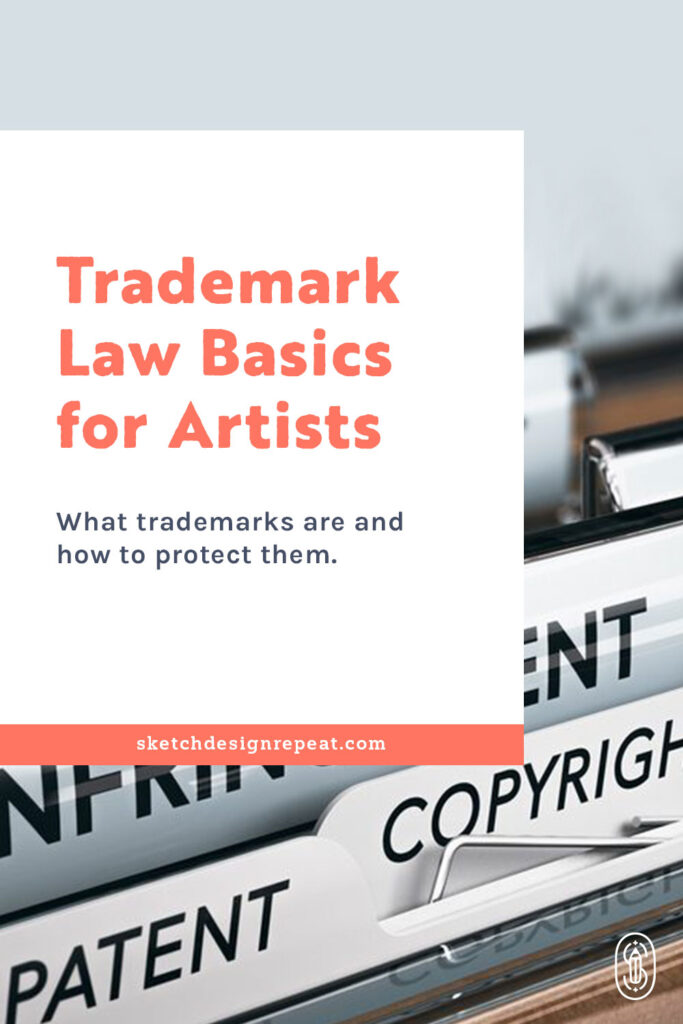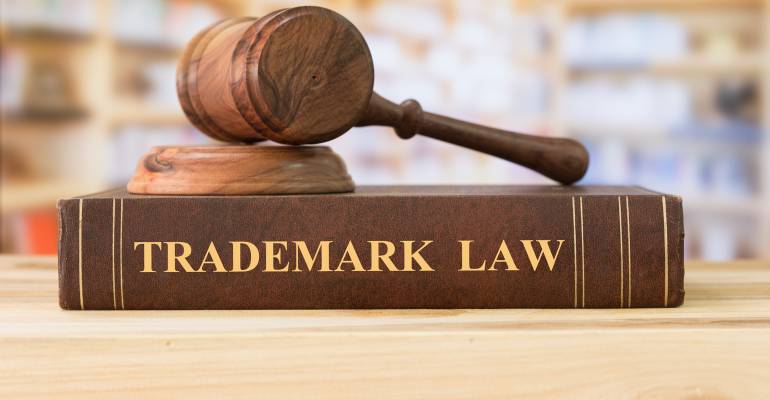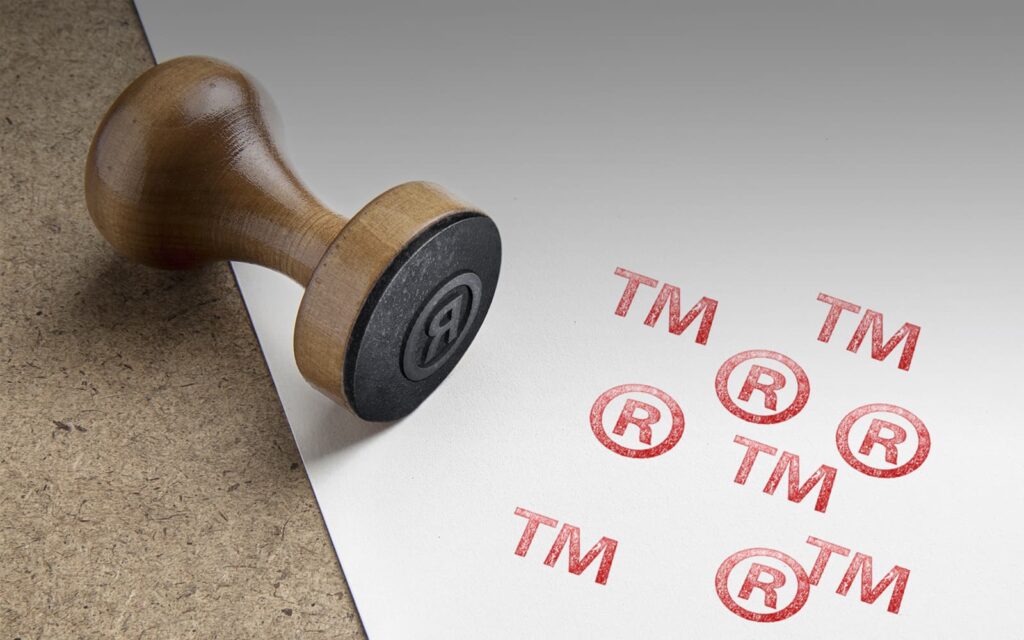An artist’s intellectual property generally includes three types: copyrights, trademarks, and patents. In previous blog posts, I’ve discussed copyrights and how to protect them. In general, copyrights apply to works of original artistic expression in a fixed and tangible medium. Patents apply to inventions, processes, and formulae. Trademarks apply to brand names, goods, and services.
As surface designers selling goods and services, trademarks are an important part of your business operation, and a working knowledge of trademark law is essential to protect one’s brand. As a guide to accomplishing this protection, this article focuses on trademark law, what trademarks are, the types of trademarks, and how to protect them.

What is a trademark?
A trademark is generally a word, phrase, symbol, or design, or a combination of these, that identifies and distinguishes the source of the goods of one party from another, typically a brand name or logo that appears on the goods or is associated with a service.
A trademark is how customers recognize you and distinguish you from your competitors. The word “trademark” can refer to both trademarks and service marks. A trademark is for goods, while a service mark is used for services.
In general, a trademark identifies the source of your goods or services; provides legal protection for your brand; and helps you guard against counterfeiting and fraud. Trademarks are protected by law to serve this source-indicating function and prevent the public from being confused about the source of the goods or services.
By doing this, a trademark also helps to assure that the trademark owner, and not an imitative competitor, will reap the rewards associated with a desirable product or service. Therefore, trademarks and service marks promise a consistent level of quality, helping the consumer to decide whether to purchase a desirable product or service again or to avoid an undesirable one.

What are the types of trademarks?
Trademarks are either common law trademarks or registered trademarks.
Common law trademarks
Common law trademarks arise from the actual use of the mark in commerce and in that sense, common law trademark is automatic. Common law trademark may allow the common law user to successfully challenge someone else’s attempt at registration or application for that specific mark.
You can and should give the public notice of your mark by using the proper trademark symbol designation each time you use your mark. More on that below.
In general, you establish common law trademarks by using them, but the rights are limited, and they only apply to the geographical area in which you are providing your goods or services. If you want stronger, nationwide protection of your marks, it is necessary to register your trademark.
Registered trademarks
Registered trademarks are those trademarks that have been registered with the U.S. Patent and Trademark Office (“USPTO”). Although common law trademark is automatic, it does not guarantee that your mark will not be infringed upon.
Creative entrepreneurs who rely on marks and logos to distinguish your goods and services from those of others of different quality, you should register your trademarks. The advantages of registering your trademarks include:
- Legal ownership of the mark;
- Public notice of your claim of ownership of the mark;
- You can sue for infringement in federal court and actually enforce your mark;
- The ability for others to search your mark in the Trademark Electronic Search System (“TESS”);
- You can record the registration with the U.S. customs service to prevent the importation of infringing goods;
- You have the right to use the registered trademark symbol; and
- Use of the U.S. registration to obtain registration abroad.
Related Article: Legal Considerations When
Designing Greeting Cards
How do I use the trademark symbols?
Every time you use your trademark, you can and should use a symbol with it. The symbol lets consumers and competitors know that you are claiming the trademark as yours. For common law trademarks related to goods, the symbol “TM” is used. “SM” is used for common law service marks. Common law trademark symbols may be used even if the mark is not registered.
Registered trademarks are designated by use of the symbol ® (“R” inside a circle) or “Reg.” with the trademark. You may use the registration symbol anywhere around the trademark, though most owners use the symbol in a superscript or subscript manner to the right of the mark.
You may only use the registration symbol with the trademark for the goods or services listed in the federal trademark application.

How do I select a trademark?
Selecting a trademark is not easy. It may be tempting to choose a word or phrase that is “catchy” and describes a feature or characteristic of your goods or services. However, as a general rule, terms that are merely descriptive of products and services cannot be protected as marks, and the more descriptive the mark is of your goods and services, the more difficult it may be to stop competitors from using it.
Similarly, in many countries, including the U.S., it is difficult to protect geographical terms and surnames as trademarks. The more distinctive the mark is, and the more well-known the mark becomes, the wider the mark’s scope of protection will be.
The strongest marks typically have no meaning in relation to the goods or services for which they are used, although marks that suggest positive qualities of the goods or service can also sometimes be strong marks.
What is a trademark clearance?
Before adopting a trademark, it is important to determine if the name you wish to use is available for use. The tools you use to make this determination depend on your plans for the name. If the name is merely a corporate name only to be used on official documents, then a search of the state corporate name database may be all you need.
However, if the name will be visible to your clients or customers (which includes most company and brand names) you should confirm that no one else is using the same or similar name in connection with the goods or services related to yours.
Trademark clearance research can range from “quick and dirty” to comprehensive and can vary in cost from a few hundred dollars to tens of thousands of dollars (for research in multiple jurisdictions).
However, for marks to be used solely in the United States the minimum standard in most circumstances is a search for the proposed mark (and marks similar in sight, sound, and meaning) in the U.S. federal and state trademark databases and various common law resources, including the USPTO’s TESS database of trademark registrations and applications. More extensive searches include numerous other types of uses, such as company name databases, trade publications, and the Internet.
Furthermore, what you don’t know can really hurt you — if no searching is done, and the mark you adopt infringes someone else’s mark, your adoption of the mark may be deemed “willful infringement,” which can triple the amount of damages you must pay to a trademark owner and may also subject you to payment of the trademark owner’s attorneys’ fees.
Accordingly, before adopting a new mark, it is advisable to have a thorough search conducted and evaluated by a qualified attorney or service provider. Someone else may already have rights to virtually the same mark, and it is better to know about that or other potentially conflicting marks before you have made an investment in your new mark. Lack of knowledge is normally not a defense to trademark infringement.

How can you lose your rights in a mark?
The most common way to lose rights in a mark is to stop using it with no intention to use it again. This is called “abandonment.” However, there are also ways in which trademark rights may be unintentionally lost.
For example, in some countries, it is possible to lose rights in a mark by licensing the mark to others without controlling the nature and quality of the goods or services the licensee offers under the mark. This concept is often referred to as “naked licensing.”
Another way in which rights may be lost is by misusing the mark — or by failing to police against the mark’s misuse by others — so that the mark ceases to indicate the source of goods or services and becomes a generic word (like escalator and cellophane, which originally were trademarks but came to be understood by the public as the generic names of the products for which they had been used as brands).
Moreover, whether a mark loses its trademark significance may vary from country to country, as is the case with ASPIRIN, which is a generic term in the United States but a protectable trademark in Europe.
To help prevent the loss of your rights in a mark, follow these standard trademark use rules:
- Use trademarks as an adjective with the generic name of the product following the mark (e.g., KLEENEX tissues)
- Do not pluralize singular marks. (e.g., OREO cookies, not OREOS)
- Do not modify a trademark from its possessive form, or make a trademark possessive. (e.g., LEVI’S jeans, not Levi jeans)
- Do not use marks as verbs or nouns. (e.g., you are NOT xeroxing, but photocopying on a XEROX copier.)
How do I protect my trademark?
Trademark rights give a right of exclusivity of use of a trademark for particular goods and/or services. However, it’s a right, not a mandate; there are no trademark police whose mission it is to protect and serve trademark owners. As a trademark owner, it is your responsibility to police and protect your trademark from infringers and careless use of the mark.
Trademark policing usually includes at least two fronts: (1) stopping infringers (and counterfeiters), and (2) maintaining proper and consistent use of the trademark.
The latter front requires the education of authorized users and the media as to the correct use of your mark. This can be accomplished by providing trademark usage guidelines (e.g., “the mark should appear in text as ‘eBay,’ not ‘EBay’ or ‘ebay’”) and correcting the media when mistakes are made.
The former front requires vigilance in the marketplace and a willingness to take quick action against wrong-doers when necessary. If you fail to police your trademark, the strength of your trademark rights will erode and may be lost altogether (e.g.,cellophane and escalator were once proprietary trademarks, and KLEENEX and XEROX are examples of trademarks that have flirted with losing their trademark significance).
Conclusion
Trademarks are an important part of an artist’s bundle of intellectual property rights. Though selecting and protecting a trademark may seem like a daunting process, it is necessary to ensure that the consuming public knows your distinctive brand and associates your brand’s quality with the mark. Having a working knowledge of trademark law is essential for both establishing and protecting your brand image through trademarks.

Written by Michael Sheridan, Esquire
Website: www.michaelsheridanesquire.com
Instagram: @michaelsheridandesigns
Michael is a surface pattern designer and commercial litigator with 25 years’ experience. He believes that a strong legal foundation is essential to business success. Michael also is an avid crafter and quilter, specializing in translating ancient Islamic tile patterns into quilt designs.